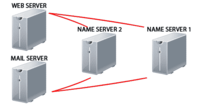Shared web hosting service
Shared web hosting service refers to a web hosting service where many websites reside on one web server connected to the Internet. This is generally the most economical option for hosting, as the overall cost of server maintenance is amortized over many customers. By choosing shared hosting, the website will share a physical server with one or different other websites. With shared hosting, a server will store different other files and would be responsible for serving up the information about them.
| Part of a series on |
| Internet hosting service |
|---|
| Full-featured hosting |
| Web hosting |
| Application-specific web hosting |
| By content format |
| Other types |
Description
The service must include system administration since it is shared by many users; this is a benefit for users who do not want to deal with it, but a hindrance to power users who want more control. In general shared hosting will be inappropriate for users who require extensive software development outside what the hosting provider supports. Almost all applications intended to be on a standard web server work fine with a shared web hosting service. But on the other hand, shared hosting is cheaper than other types of hosting such as dedicated server hosting. Shared hosting usually has usage limits and hosting providers should have extensive reliability features in place. Shared hosting services typically offer basic web statistics support, email and webmail services, auto script installations, updated PHP and MySQL, basic after-sale technical support that is included with a monthly subscription. It also typically uses a web-based control panel system. Most of the large hosting companies use their own custom developed control panel. Control panels and web interfaces can cause controversy however since web hosting companies sometimes sell the right to use their control panel system to others. Attempting to recreate the functionality of a specific control panel is common, which leads to many lawsuits over patent infringement.[1]
In shared hosting, the provider is generally responsible for managing servers, installing server software, security updates, technical support, and other aspects of the service. Most servers are based on the Linux operating system and LAMP (software bundle). Some providers offer Microsoft Windows-based or FreeBSD-based solutions. Server-side facilities for either operating system (OS) have similar functionality (for example: MySQL (database) and many server-side programming languages (such as the widely used PHP programming language) under Linux, or the proprietary SQL Server (database) and ASP.NET programming language under Microsoft Windows.
There are thousands of shared hosting providers in the United States alone. They range from "mom-and-pop shops" and small design firms to multimillion-dollar providers with hundreds of thousands of customers. A large portion of the shared web hosting market is driven through pay per click (PPC) advertising or affiliate programs while some are purely non-profit.
Shared web hosting can also be done privately by sharing the cost of running a server in a colocation centre; this is called cooperative hosting.
Implementation
Shared web hosting can be accomplished in two ways: name-based and Internet Protocol-based (IP-based), although some control panels allow a mix of name-based and IP-based on the one server.
IP-based
In IP-based virtual hosting, also called dedicated IP hosting, each virtual host has a different IP address. The web server is configured with multiple physical network interfaces or virtual network interfaces on the same physical interface. The web server software uses the IP address the client connects to in order to determine which website to show the user. The issue of IPv4 address exhaustion means that IP addresses are an increasingly scarce resource, so the primary justification for a site to use a dedicated IP is to be able to use its own SSL/TLS certificate rather than a shared certificate.
Name-based
In name-based virtual hosting, also called shared IP hosting, the virtual hosts serve multiple hostnames on a single machine with a single IP address. This is possible because when a web browser requests a resource from a web server using HTTP/1.1 it includes the requested hostname as part of the request. The server uses this information to determine which website to show the user.
Understanding DNS and name servers

DNS stands for "Domain Name System". The domain name system acts like a large telephone directory and in that it's the master database, which associates a domain name such as www.wikipedia.org with the appropriate IP number. Consider the IP number something similar to a phone number: When someone calls www.wikipedia.org, the ISP looks at the DNS server, and asks "how do I contact www.wikipedia.org?" The DNS server responds, for example, "it can be found at: 91.198.174.192.". As the Internet understands it, this can be considered the phone number for the server that houses the website. When the domain name is registered/purchased on a particular registrar's "name server", the DNS settings are kept on their server, and in most cases point the domain to the name server of the hosting provider. This name server is where the IP number (currently associated with the domain name) resides.
See also
- Dedicated hosting service
- Free web hosting service
- Virtual machine
- Virtual private server
- Web hosting service
- Web server
References
- Berr, Jonathan (June 6, 2006). "Go Daddy Gets Sued". The Street. THE STREET. Retrieved 15 September 2017.